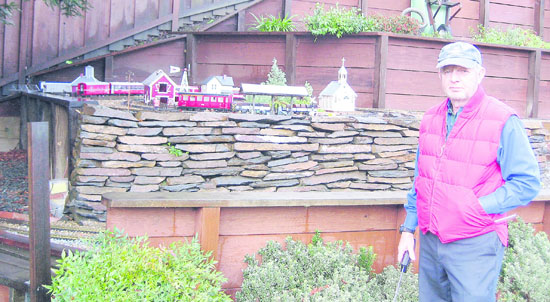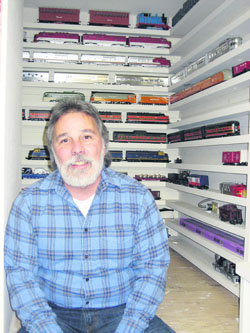| | Published December 24th, 2008
| Toy Trains Brighten the Holidays and Cheer Hobbyists Year-Round
| | By Jennifer Wake |  | | Photos Andy Scheck
|
Something about toy trains enthralls children - especially during the holidays. Whether it's grasping the small wooden trains crafted for young hands by Brio, or watching a tiny puff of smoke from a realistic American Flyer train engine, toy trains and model railroads have brought smiles to children's faces for decades.
 For many Lamorinda residents, this childhood wonder has continued as a life-long hobby.
For many Lamorinda residents, this childhood wonder has continued as a life-long hobby.
 Orinda resident John April was 9 years old when he got his first American Flyer train set. "Every Christmas I added a little something to it," he says. April's extensive train collection now lines the walls of his "train room" that adjoins his office downstairs. His layout includes six tracks, three which circle through a large tunnel, multiple train sets, ceramic collectible cars from the '50s, and collectible glass buildings that light up with the flip of a switch.
Orinda resident John April was 9 years old when he got his first American Flyer train set. "Every Christmas I added a little something to it," he says. April's extensive train collection now lines the walls of his "train room" that adjoins his office downstairs. His layout includes six tracks, three which circle through a large tunnel, multiple train sets, ceramic collectible cars from the '50s, and collectible glass buildings that light up with the flip of a switch.
 Trains were always a part of April's life. Originally from St. Louis, April says his childhood basement was filled with hockey sticks and toy trains.
Trains were always a part of April's life. Originally from St. Louis, April says his childhood basement was filled with hockey sticks and toy trains.
 "When we moved out here in 1986, I met some guys collecting toy trains," April says. "It all got out of hand when I joined the Train Collectors Association." That's when he started adding to his collection of five American Flyer sets.
"When we moved out here in 1986, I met some guys collecting toy trains," April says. "It all got out of hand when I joined the Train Collectors Association." That's when he started adding to his collection of five American Flyer sets.
 The Association meets the second Saturday of the month in the VFW Hall in Lafayette, offering a way for members to buy and trade trains at meetings. April has made life-long friends through model train organizations like TCA, and his entire family has gotten into the hobby.
The Association meets the second Saturday of the month in the VFW Hall in Lafayette, offering a way for members to buy and trade trains at meetings. April has made life-long friends through model train organizations like TCA, and his entire family has gotten into the hobby.
 "My wife likes to show people the trains, and my daughter, three sons, and four grandchildren all worked their way into the hobby and received trains from us," April says.
"My wife likes to show people the trains, and my daughter, three sons, and four grandchildren all worked their way into the hobby and received trains from us," April says.
 Leo Schiavello of Lafayette had a family connection to toy train sets as well while growing up in New York, where his family would set up Lionel trains every Christmas.
Leo Schiavello of Lafayette had a family connection to toy train sets as well while growing up in New York, where his family would set up Lionel trains every Christmas.
 "I always wanted a permanent layout," Schiavello says, who received his first Lionel train in the early 1950s. Although he kept his trains in boxes for years, in 1991 his son showed a fascination with a model railroad. Schiavello immediately brought out his trains and started working on his own layout. He constructed a room over the garage which included a vacuum system attached to his garage's Shop-Vac.
"I always wanted a permanent layout," Schiavello says, who received his first Lionel train in the early 1950s. Although he kept his trains in boxes for years, in 1991 his son showed a fascination with a model railroad. Schiavello immediately brought out his trains and started working on his own layout. He constructed a room over the garage which included a vacuum system attached to his garage's Shop-Vac.
 "Dust and pollen will really muck up the works," he says.
"Dust and pollen will really muck up the works," he says.
 Schiavello has spent the past four years building his open benchwork layout. "I don't have scenery yet," he says. "Most people have layouts on sawhorses with plywood, but I plan to add contours to my landscape." The real challenge, he says, was with the controls. Schiavello opened up a wall to build a control panel that attaches to toggle controls for the switch track.
Schiavello has spent the past four years building his open benchwork layout. "I don't have scenery yet," he says. "Most people have layouts on sawhorses with plywood, but I plan to add contours to my landscape." The real challenge, he says, was with the controls. Schiavello opened up a wall to build a control panel that attaches to toggle controls for the switch track.
 An industrial engineer by training, Schiavello knows a lot about wiring, but despite the intricacies, he firmly believes that model railroading is a great hobby for kids. "It pulls together so many skills: woodworking, scenery, electrical," he says. "You don't need to be a 'Jack of all trades' to do this. You can start with a basic loop around a Christmas tree and add from that."
An industrial engineer by training, Schiavello knows a lot about wiring, but despite the intricacies, he firmly believes that model railroading is a great hobby for kids. "It pulls together so many skills: woodworking, scenery, electrical," he says. "You don't need to be a 'Jack of all trades' to do this. You can start with a basic loop around a Christmas tree and add from that."
 Like many railroaders, Schiavello read books such as "Operating O and O-27 Trains," "Modern Railroading with Lionel Trains," and Greenberg's "Wiring Your Lionel Layout" to learn model railroad techniques. He also subscribes to several magazines that list vendors and offer great suggestions for layout and scenery.
Like many railroaders, Schiavello read books such as "Operating O and O-27 Trains," "Modern Railroading with Lionel Trains," and Greenberg's "Wiring Your Lionel Layout" to learn model railroad techniques. He also subscribes to several magazines that list vendors and offer great suggestions for layout and scenery.
 "There's so much work to do on your own," he says. "I play up here during my vacations and on rainy days."
"There's so much work to do on your own," he says. "I play up here during my vacations and on rainy days."
 Moraga resident Tom Westhoff's experience has been different.
Moraga resident Tom Westhoff's experience has been different.
 Unlike Schiavello and April, Westhoff didn't grow up with a love of toy trains - at least no more so than other typical kids in his neighborhood, he says. After a trip with his wife to New Mexico - one of the United States' railroad hubs - he came back thinking model railroading would be "something fun to do."
Unlike Schiavello and April, Westhoff didn't grow up with a love of toy trains - at least no more so than other typical kids in his neighborhood, he says. After a trip with his wife to New Mexico - one of the United States' railroad hubs - he came back thinking model railroading would be "something fun to do."
 Westhoff's G-scale garden railroad loops throughout his backyard, running under a bridge at one point in his layout. Although the trains can withstand the elements and are heartier than some smaller-gauge models, he still needs to listen closely while the trains are running. "If I hear one stop, I need to check on it to make sure something didn't go wrong."
Westhoff's G-scale garden railroad loops throughout his backyard, running under a bridge at one point in his layout. Although the trains can withstand the elements and are heartier than some smaller-gauge models, he still needs to listen closely while the trains are running. "If I hear one stop, I need to check on it to make sure something didn't go wrong."
 Like other collectors, Westhoff has a wall of trains, as well as "extras" from the hobby, including a train crossing sign and speakers that produce train sound effects.
Like other collectors, Westhoff has a wall of trains, as well as "extras" from the hobby, including a train crossing sign and speakers that produce train sound effects.
 After six years, Westhoff now has 100 cars on his continuous loop garden track - each battery powered with its own receiver. "Carolyn agreed to let me take over the garden," he says. "I started with a single loop on the deck, and now it takes five minutes for a train to go around the length of the track."
After six years, Westhoff now has 100 cars on his continuous loop garden track - each battery powered with its own receiver. "Carolyn agreed to let me take over the garden," he says. "I started with a single loop on the deck, and now it takes five minutes for a train to go around the length of the track."
 One section of the track that Westhoff calls "the Bluffs" is replete with a small town chapel, cars, buildings, and miniature trees. Another area called "the Trees" is named after two miniature pine trees planted on a slope next to the tracks. The trains light up at night. "People love to come over and watch the trains," he says.
One section of the track that Westhoff calls "the Bluffs" is replete with a small town chapel, cars, buildings, and miniature trees. Another area called "the Trees" is named after two miniature pine trees planted on a slope next to the tracks. The trains light up at night. "People love to come over and watch the trains," he says.
 For all three men, model railroading is all about remembering that although their trains are collectible, they are still toys.
For all three men, model railroading is all about remembering that although their trains are collectible, they are still toys.
 "I can't wait for my youngest grandson to get a little older," April says. "He loves Brio, and we've sent him that, but I can't wait to send him his first electric train."
"I can't wait for my youngest grandson to get a little older," April says. "He loves Brio, and we've sent him that, but I can't wait to send him his first electric train."
 (The Walnut Creek Model Railroad Society will have its last holiday show on Friday, Dec. 26 from 8 to 10 p.m. at 2751 Buena Vista Avenue in Walnut Creek (near Larkey Park). For info, visit www. wcmrs.org.)
(The Walnut Creek Model Railroad Society will have its last holiday show on Friday, Dec. 26 from 8 to 10 p.m. at 2751 Buena Vista Avenue in Walnut Creek (near Larkey Park). For info, visit www. wcmrs.org.)

|
 | | Tom Westhoff of Moraga with his garden railroad Photo Jennifer Wake
|
 | | Leo Schiavello, Lafayette
Photo Jennifer Wake
|  |
John April, Orinda
Photo Jennifer Wake |
|
